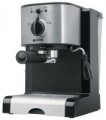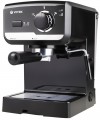Water tank
The volume of the water tank provided in the coffee maker; for turkish electric coffee pot (see "Type"), this paragraph indicates the actual working volume of the turk.
The larger the tank, the more coffee you can make without refilling the device; on the other hand, a large capacity, respectively, affects the dimensions, weight and price of the device. Therefore, manufacturers select this parameter in accordance with the general level of the coffee maker and the features of its intended use. So, you rarely have to make more than two cups of coffee at the same time, and 300 – 400 mL for such cases is usually more than enough for home use. And for use in a coffee shop or restaurant, where coffee is made often and in large quantities,
large-sized devices are produced, the volume of which is already calculated in liters; recommendations for choosing the volume of a coffee maker for professional use can be found in special sources.
Pressure
This parameter is relevant for espresso coffee makers and geyser models — where coffee is prepared at increased steam pressure. In the second case, this parameter can be ignored — in "geysers" the extraction of soluble substances from coffee occurs mainly due to high temperature. But for espresso coffee makers, pressure is a key characteristic. All such devices can be divided into two categories. The first is the entry-level models, in which the pressure is only 4 – 5 bar. Such a modest figure is compensated by the high temperature of the steam, due to which the coffee aroma is relatively weak, but quite a lot of caffeine is extracted into the drink. More advanced espresso makers provide
15 bar and even higher (
19 bar and
20 bar); this significantly affects the cost, but the coffee turns out to be as rich and aromatic as possible.
Power consumption
Power consumption of the coffee maker. Usually, this indicator is comparable with the power of the heater installed in the device.
This parameter is selected by the manufacturer, taking into account other performance characteristics (type of device, tank volume, additional functions, etc.), so that the coffee maker can effectively cope with its tasks. Therefore, in fact, power is of secondary importance: it is worth deciding first of all on other practical points, and only then look at power when choosing. In general, a more powerful coffee maker (ceteris paribus) will quickly cope with the preparation of coffee, but it will also cost more.

